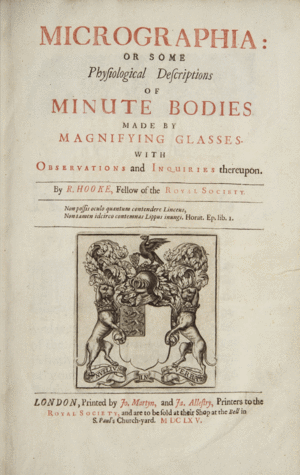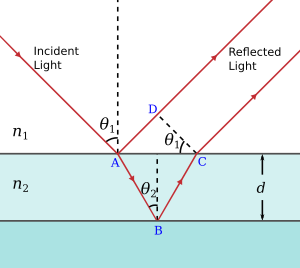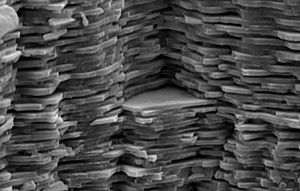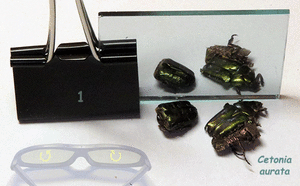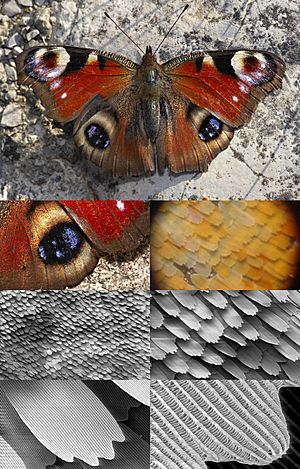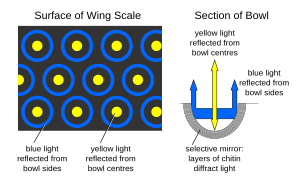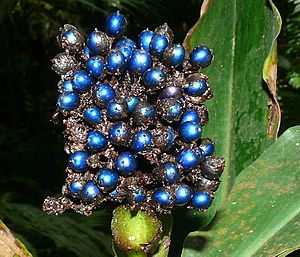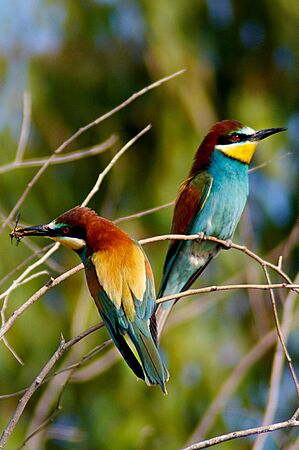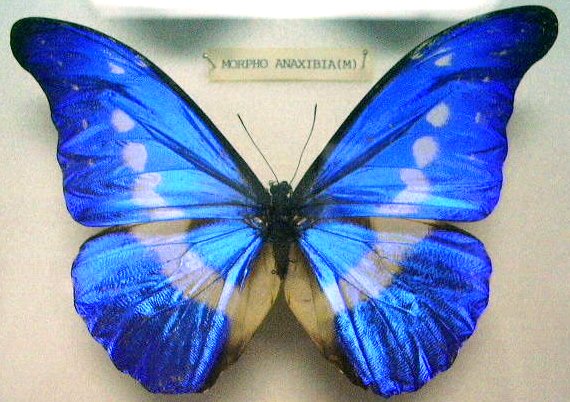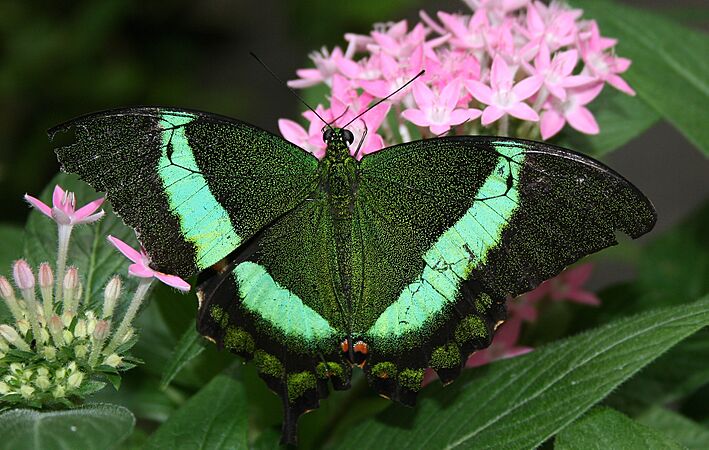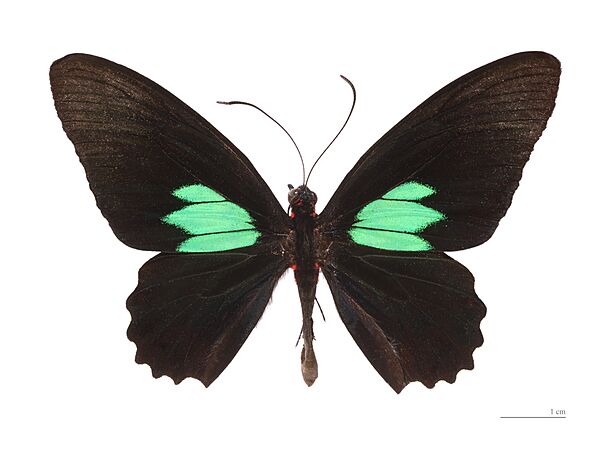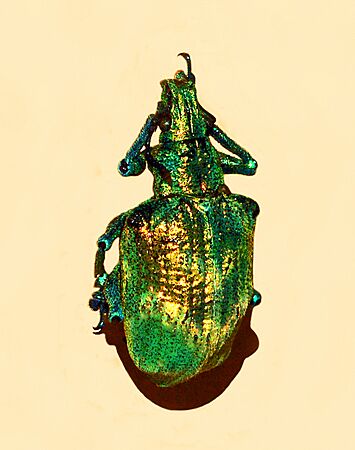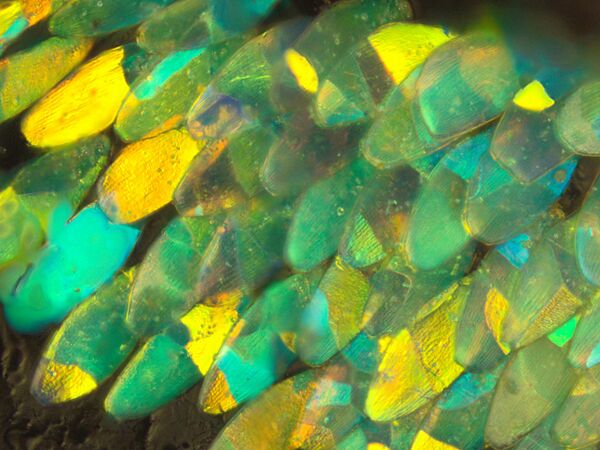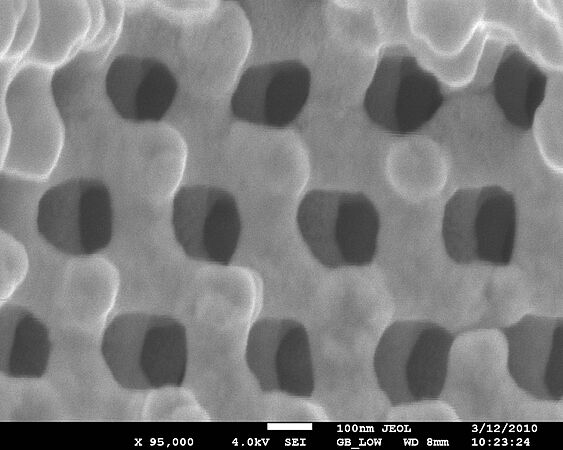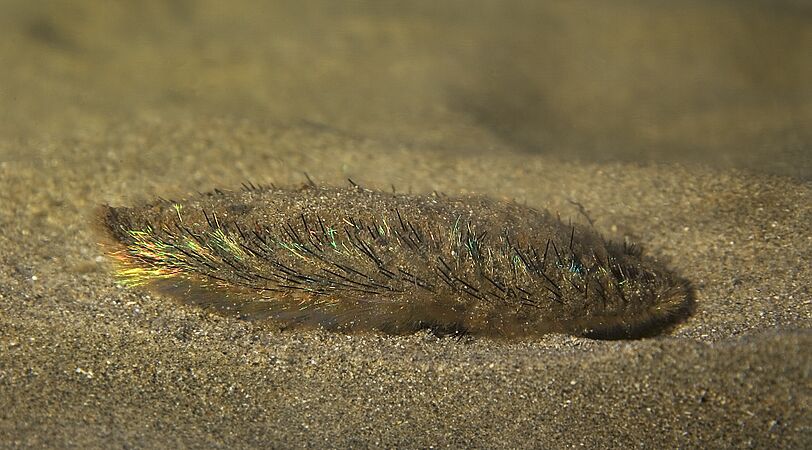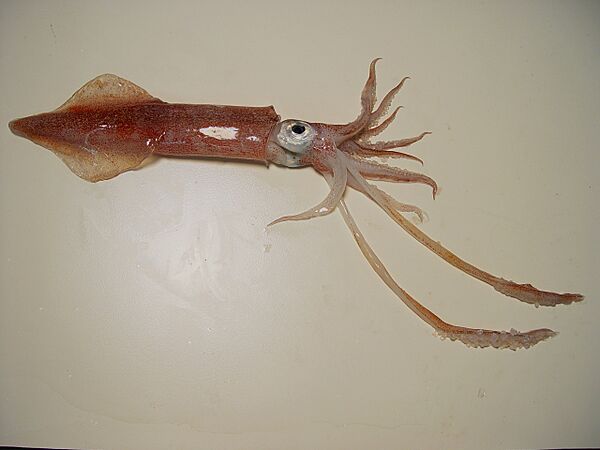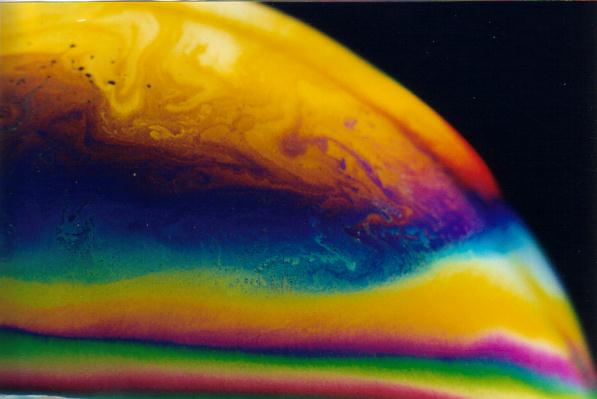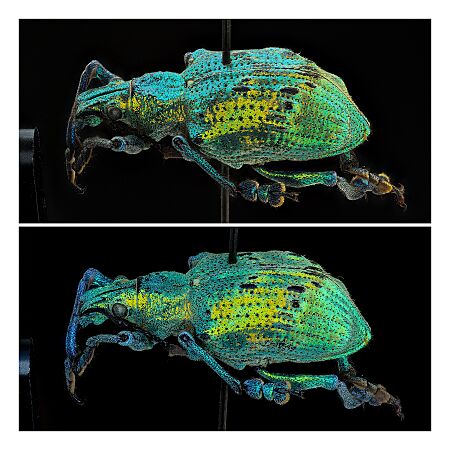Structural coloration facts for kids
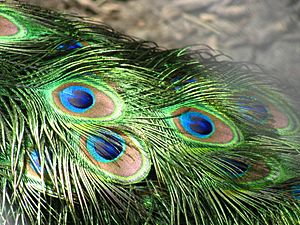
Structural coloration is how some animals and plants make amazing colors without using pigments (like the colors in paint). Instead, they use tiny structures on their surfaces that are so small they can play with visible light. Think of it like a tiny, natural light show!
Sometimes, structural colors mix with pigments. For example, peacock tail feathers have a brown pigment, but their tiny structures also reflect blue, green, and turquoise light. This makes them look shiny and change color, which is called iridescence.
Scientists Robert Hooke and Isaac Newton first noticed structural coloration. Later, Thomas Young explained how it works using something called wave interference. He said that when light hits very thin films, some light bounces off the top, and some goes through and bounces off the bottom. These two light waves then mix. Depending on the angle, they can either make the color brighter (constructive interference) or cancel each other out (destructive interference). This is why you see different colors from different angles.
In animals like birds and butterflies, these tiny structures can be like diffraction gratings, special mirrors, or even photonic crystals. Some cuts of meat also show structural color because of how their muscle fibers are arranged. In plants, like the amazing blue berries of Pollia condensata, tiny spiral structures inside the cells create the color. Even the shiny look of buttercups comes from thin layers on their petals, combined with yellow pigment.
Structural coloration is also inspiring new technologies. Scientists are trying to copy these natural designs to make things like super colorful surfaces, adaptive camouflage (which changes color to hide), and special glass that doesn't reflect much light.
Contents
History of Discovery
In 1665, Robert Hooke wrote about the "fantastic" colors of peacock feathers in his book Micrographia. He looked at them with a microscope and saw that the tiny parts of the feathers were like "thin plated bodies." He thought these thin layers reflected light in a special way, just like mother-of-pearl shells. He also noticed that when the feathers got wet, their colors disappeared. This showed him that the colors came from how light was reflected and refracted, not from a dye.
In 1704, Isaac Newton also wrote about peacock feathers in his book Opticks. He agreed with Hooke, saying that the colors came from the "thinness of the transparent parts of the Feathers." He thought it was because of the very fine hairs on the feathers.
Later, Thomas Young (1773–1829) added to Newton's ideas. In 1803, he showed that light could also act like a wave. He explained that light could bend around edges and create interference patterns, which helped explain how structural colors work.
How Structural Color Works
Color from Structure, Not Pigment
Structural coloration happens because of how light interacts with tiny structures, not because of pigments. These colors appear when a material has fine parallel lines, or is made of very thin layers, or has other tiny structures that are about the same size as the wavelength of light.
This is why many birds, like the bee-eater and kingfisher, have bright blue and green feathers. It's also why many butterfly wings and beetle shells are so colorful. Often, these colors are iridescent, meaning they seem to change as you move, like peacock feathers or nacre (mother-of-pearl). This happens because the color you see depends on your viewing angle.
Structural colors can also mix with pigment colors. Peacock feathers, for example, have brown melanin pigment, but their amazing colors come from their structure. Buttercup petals have yellow pigments and also thin layers that make them shiny.
The Magic of Iridescence
Thomas Young explained iridescence in 1803. It happens when extremely thin films reflect light. Part of the light bounces off the top surface, and the rest goes through and bounces off the bottom surface. These two reflected light waves travel back in the same direction. But the light from the bottom surface travels a little farther. Because of this, the two waves can be out of sync.
When the waves are perfectly in sync (one or more whole wavelengths apart), they add up and create a strong, bright reflection of a specific color. At other angles, they might cancel each other out, making the reflection weak. This means a thin film reflects only one pure color at a certain angle, but different colors at different angles. That's why a butterfly's wing or a bird's feather seems to change color as it moves!
How Colors Are Made: Different Structures
Fixed Structures
Many fixed structures can create structural colors. These include things like diffraction gratings, special mirrors, and photonic crystals. These structures can be much more complex than just a single thin film. They can be stacked up to make colors brighter or to make them look the same from many angles. Each type of structure solves the problem of making a bright color in a specific way.
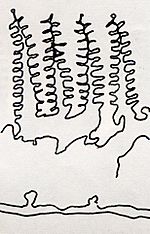
A diffraction grating is like a surface with many tiny, parallel lines. Layers of chitin (a tough material) and air create the iridescent colors on many butterfly wings and peacock tail feathers. Hooke and Newton were right that interference causes these colors, but the tiny structures were too small for their microscopes to see clearly. Another way to make a diffraction grating is with tree-shaped patterns of chitin, like in the wings of the bright tropical Morpho butterflies.
Photonic crystals are like tiny, perfectly arranged patterns that control light. In the emerald-patched cattleheart butterfly (Parides sesostris), photonic crystals are made of tiny holes in the chitin of its wing scales. These holes are about 150 nanometres wide and spaced out evenly. This makes the butterfly's scales reflect green light evenly from different angles, so it doesn't look iridescent. In a weevil from Brazil called Lamprocyphus augustus, its shell has iridescent green scales. These scales contain tiny crystal patterns that are arranged in all directions, making the green color look bright and almost the same from any angle.
Selective mirrors create interference effects in the wing scales of the emerald swallowtail butterfly (Papilio palinurus). These scales have tiny, bowl-shaped pits lined with many layers of chitin. These pits act like special mirrors for two colors of light. Yellow light bounces directly from the center of the pits, while blue light bounces twice off the sides of the pits. Together, they look green, but under a microscope, you can see yellow spots surrounded by blue circles.
Crystal fibres are like tiny, hollow tubes arranged in a pattern. They create the bright, iridescent colors of the bristles on Aphrodita, the sea mouse. These colors are a warning to predators not to attack. The walls of the hollow bristles form a hexagonal (six-sided) pattern, which acts like a photonic crystal. This makes Aphrodita one of the most iridescent sea creatures.
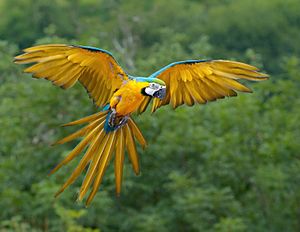
Deformed matrices are like spongy materials with randomly placed tiny channels. These create the soft, non-iridescent blue color of the blue-and-yellow macaw (Ara ararauna). Because the reflections are not all in the same direction, the colors don't change much with angle, so they aren't iridescent.
Spiral coils are made of tiny, stacked spirals of cellulose (the main material in plant cell walls). These create the amazing blue color of the "marble berries" from the African plant Pollia condensata. This is the most intense blue color known in nature! The berry's surface has layers of cells with thick walls, and inside are spirals of transparent cellulose. These spirals are spaced just right to make blue light brighter. Each cell has its own thickness of fibers, so it reflects a slightly different color, making the berry look like it's made of tiny blue, green, purple, and red dots. Pollia is one of the first plants known to use structural coloration.
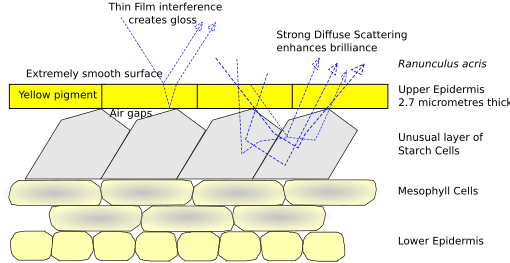
Thin film with diffuse reflector is how buttercup petals get their brilliant yellow shine. This is rare in plants. The very smooth top layer of the petal acts like a shiny, iridescent thin film. Underneath, special starch cells form a strong reflector, making the flower even brighter. The curved petals also act like a dish, directing the sun's heat to the center of the flower, keeping it a few degrees warmer.
Surface gratings can be seen on cuts of meat. When the muscle fibers are exposed, their regular pattern can diffract light, creating structural colors. The color you see depends on your viewing angle.
Variable Structures
Some animals, like cephalopods (squid and octopuses), can change their colors very quickly to hide or to send signals. They do this using special proteins that can change their shape. For example, in the skin of the Doryteuthis pealeii squid, special proteins called reflectins can stack tightly or loosely, changing how thick a layer is. Since their skin has many layers of these proteins, changing the spacing changes the color of light reflected.
Blue-ringed octopuses usually hide, showing camouflage patterns. But if they feel threatened, they quickly change to bright yellow, and their 50-60 rings flash bright iridescent blue in less than a second! In the greater blue-ringed octopus (Hapalochlaena lunulata), the rings have many layers of special cells called iridophores that reflect blue-green light. Muscles control these rings. Normally, the rings are hidden by muscles. When these muscles relax and others tighten, the bright blue rings are shown.
Examples of Structural Color
-
European bee-eaters get their bright colors from tiny structures in their feathers.
-
The amazing colors of Morpho butterflies like Morpho helena come from tiny, tree-shaped structures.
-
The male Parotia lawesii bird of paradise uses his breast feathers to signal to females. They switch from blue to yellow!
Structural Color in Technology
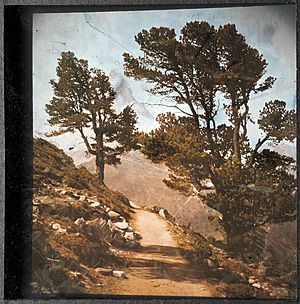
Gabriel Lippmann won a Nobel Prize in 1908 for his work on a way to take color photographs using structural coloration. His "Lippmann plate" used a special film that recorded how light waves interfered. When white light was shined through it, the original colors of the photo appeared!
Today, scientists are still studying structural coloration for new technologies. For example, a fabric called Morphotex was created in 2010. It's an undyed fabric that gets its color from tiny structures, just like Morpho butterfly wings. It's made of 61 thin layers of two different plastics. This fabric can be made in red, green, blue, and violet.
Structural coloration could also be used to make active camouflage for the military. This would be fabric that could change its colors and patterns to match its surroundings, just like chameleons and cephalopods do. Also, being able to change how much light is reflected could lead to super-fast optical switches for computers.
The eyes of some insects, like the housefly and moths, have tiny bumps that reduce reflection. This helps them see better by letting more light in. Scientists are trying to copy these "moth-eye" nanostructures to make glass that doesn't reflect much light. This could be used for windows, solar cells, and even military stealth technology.
See also
 In Spanish: Coloración estructural para niños
In Spanish: Coloración estructural para niños
- Animal coloration
- Camouflage
- Patterns in nature


